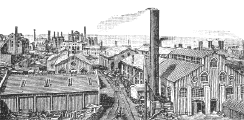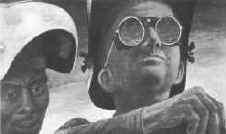 |
Marketing the Machine Age: Industrial Archaeology and Heritage
Tourism in America’s "Rust Belt"
Page 6
|
 |
|
|
|
|
| |
 19
View of the Lemon House, rear, prior to recent alterations.
(Photo: NPS) 19
View of the Lemon House, rear, prior to recent alterations.
(Photo: NPS)
|
|
Mud and coal dust. Where
do these details, selectively teased from a larger body of
archeological data, lead us? They invite us to examine the
view we present to the public at this industrial site. Until
recently the Lemon House sat surrounded by a verdant sea of
immaculately tended lawn. Over the last several years this
manicured lawn has been largely replaced by a restored meadow
and orchard, and a wraparound porch reconstructed at the south
and east facades of the Lemon House. The careful restoration
of these elements of the historic landscape, along with
additions to the parks interpretive program, do much to remedy
the false impression conveyed by the sight of a stately stone
building flanked by closely cropped rolling green grass. But,
still, the mud and coal dust are absent from the scene.
Compelling practical considerations of park
management aside, we can not hope to fully recreate the
physical by-products of a set of industrial activities which
long ago ceased. It is not just the mud and coal dust, gone
too are the clouds of gritty black smoke mingled with steam
billowing from the stacks of the engine house-- and from the
locomotives making the circuit on the levels. These, and a
thousand and one other small details are gone from the scene,
not to be replaced by our best efforts at reconstruction.
We are thus faced with a challenge. That
which we can not replicate in a restored landscape must be
incorporated into other aspects of site interpretation.
Drawing on the best available information from archeology,
historic research and oral history, a carefully crafted blend
of museum displays, wayside plaques, and interpretation by
on-site guides must be fashioned with an eye to the overall
picture conveyed to the visitor.
The failure to view site interpretation as a
whole can have serious consequences. The danger lies in the
real and very destructive possibility that we convert the past
into a nostalgic parody of itself. In a series of
illustrations, George Storm, a locally born artist who in his
youth frequently traveled on the Portage Railroad, has left us
with his view of the railroad (Toogood 1972:7). One painting,
believed to have been completed around 1895, shows the head of
plane 6.
|
|
|
|

|
 20 This George Storm painting shows the
Lemon House (left) and a waiting locomotive (right)
with Engine House 6 in the background.
20 This George Storm painting shows the
Lemon House (left) and a waiting locomotive (right)
with Engine House 6 in the background.
|
|
|
|
| This image does
show a steaming locomotive, but missing here also are the
mud and coal dust. Instead we are treated to a rather idyllic
view--a picturesque landscape. Executed with charm, the
image is no doubt softened by childhood memories and the
passage of time. Such nostalgic vision can become a barrier
to understanding. While it signals a connection with the
past, it can also insulate us from the rough edges. And
it can obscure the hard questions that a more nuance consideration
of history evokes.
A dozen years ago now, and in another
context, Raymond Williams observed that the idyllic landscapes
installed on the grand estates of Britain in the wake
of the enclosure movement were, despite their seemingly
naturalistic intention, carefully constructed analogies
to neo-pastoral art. These creations presented, in Williams’
words "...a rural landscape emptied of rural labour
and labourers…from which the facts of production had been
banished" (1973:125). The nostalgic impulse is often
rooted in more than a simple and naive approach to the
past. Indeed, the seeming innocence of this mode of representation
often serves as a veil behind which, in the interest of
the present political moment, the contentious forces which
shape history are safely hidden from view.
|
|
|